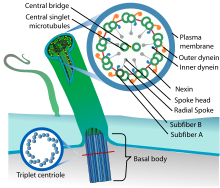COACH syndrome
[10] Coloboma of the eye is visible in the retina as "hole" in its structure, and causes low vision, possible sensitivity to light and variance in size of the eyeball.
[11][12] The build-up of tissue in the liver, known as hepatic fibrosis, may cause symptoms such as jaundice, ascites, abnormal bleeding and enlarged spleen.
[2] Due to generational familial linkage and the frequency of siblings sharing inheritance of COACH syndrome, it is classified as an autosomal recessive disorder.
COACH syndrome is a ciliopathy, a group of diseases categorized by irregular behavior of the primary cilia, which are involved in cell division, transportation, communication and tissue differentiation.
[13] The diagnosis of COACH syndrome is based on the presence of all five categories; cerebellar vermis hypoplasia, oligophrenia, congenital ataxia, coloboma, and hepatic fibrosis.
[10] Oligophrenia, more commonly known as intellectual disability, is diagnosed using personalized testing to measure intelligence and physical examination for anomalies and facial dysmorphia.
[15] Kidney cysts can be discovered using ultrasound techniques, and monitoring of the patient's urine concentrating ability for any abnormalities can indicate other renal complications such as nephronophthisis.
Programs for special education and occupational therapy for speech and motor impairment can improve symptoms of intellectual disability and quality of life for patients.
[14] Some children with hypotonia and other motor skill complications may need a nasogastric feeding tube to ensure adequate nutrients are received and breathing is undisrupted.
There are multiple methods, such as the targeting or clearance of collagen- generating cells, deactivation of receptors to certain cytokines and inhibition of connective tissue growth factor (CTGF).
[19] The first official report of COACH syndrome was published in 1974 at the Montreal Children's Hospital, identifying two siblings, a brother and sister, presenting with all 5 components of the disorder.
The siblings both presented with the symptoms of congenital hepatic fibrosis, choroidal colobomata, dysmorphic features, polycystic kidneys, encephalopathy causing intellectual disability and growth problems.
The report concludes that the symptoms presented by the siblings are not completely consistent with any other existing disorders, and thus prompted further research into the official classification of COACH syndrome in 1989.

